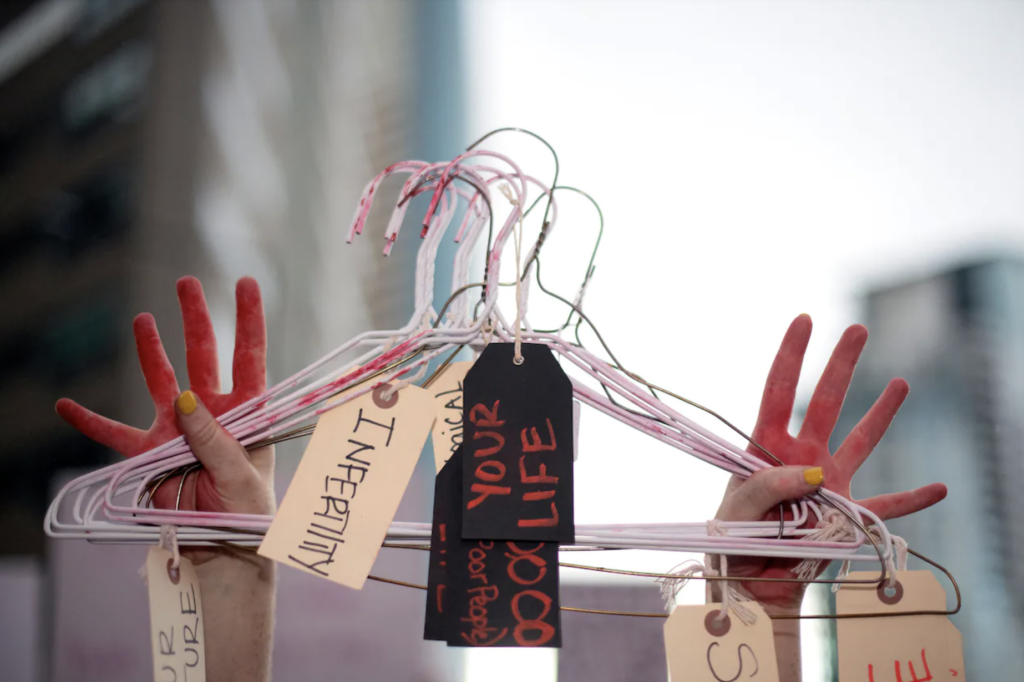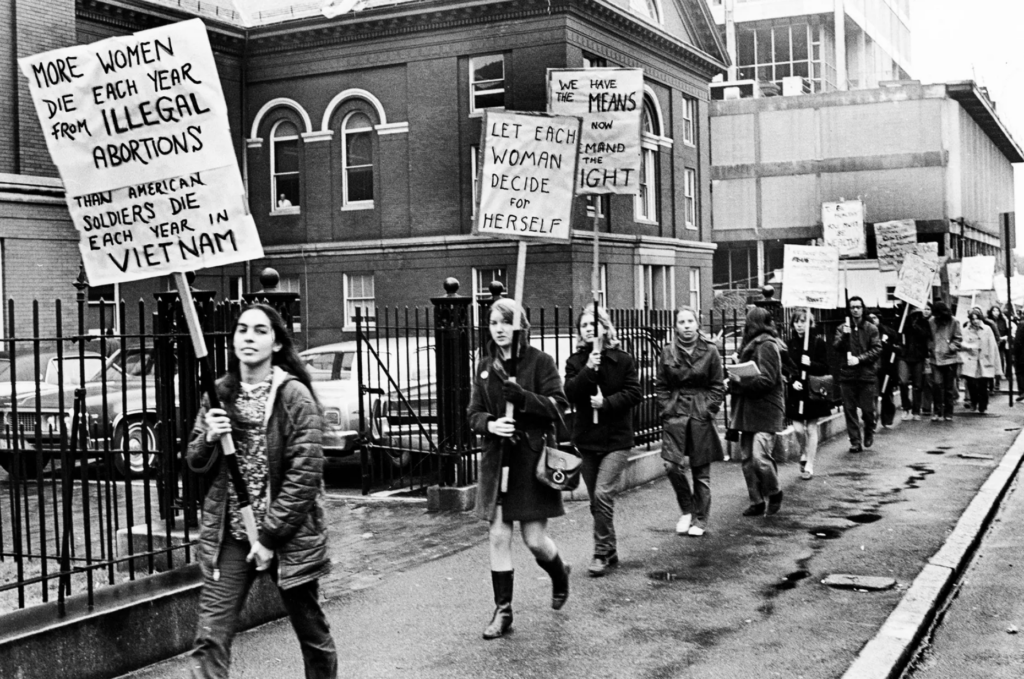
A ubiquitous symbol in modern pro-choice protests, the coat hanger is a painful reminder of the extreme measures American women were forced to take to preserve their bodily autonomy before the landmark 1973 Roe v. Wade ruling. In 2022, just before the case’s 50th anniversary, Roe v. Wade was overturned, in a culmination of decades of mounting threats to reproductive rights; the resolution led to a cascade of trigger laws in conservative states limiting or outright banning abortion, which now define the post-Roe landscape. As in-clinic abortion becomes inaccessible to more and more Americans, many are turning towards DIY abortion as an alternative, unearthing cultural memories of a pre-Roe world in the process.
DIY abortions often conjure grisly images of agonizing pain and dangerous infections, an enduring partial memory strengthened by the prevalence of material artifacts and symbols, such as the infamous coat hanger that has been mobilized in support of reproductive rights around the world. However, today’s DIY abortions most frequently take the form of two pills: mifepristone and misoprostol, which induce miscarriages and are typically prescribed by doctors. Although the two-pill procedure is FDA-approved for up to 10 weeks [1], with a 0.31% serious complication rate [2] and 95% effectiveness [3], obtaining the pill still poses a barrier to many women—abortion networks and funds, such as Dutch organization Women on Web, usually prioritize locations that outlaw abortion entirely [4], leaving women in states that have seen abortion clinics becoming few and restrictions being added effectively stranded.
“This has to look like a miscarriage.”
“I cry and pray every night that the Lord take this child from me somehow.”
“Please, I am out of options.”
These messages sent to abortion networks [4] reflect a universal sense of desperation, spanning class, marital status, age, and time. Mirroring the pre-Roe era, the barriers faced by these women are startlingly similar to the ones being built today: with legal abortions only available in a few major cities [5], women who were in other states and unable to travel also found themselves physically stranded, unable to safely terminate their pregnancies.
Both in the pre-and post-Roe era, we find that those seeking abortion do not give up, but instead turn to increasingly dangerous methods. Turpentine is just one recurring motif—women drink it, insert cotton balls soaked with it into their vaginas, and inject it into their abdomens [4]. Multiple current-day and historical cases chronicle the physical last resorts taken by desperate women in the absence of safe methods, including the insertion of objects like the infamous wire coat hanger and even instances of women shooting themselves in the stomach.
In response to these lethal methods and official regulations that ignored women’s plight, the 1960s saw vernacular pushback in the form of underground abortion groups, like the Chicago-based Jane Collective, which provided safe abortion services to roughly 11,000 women between 1969 and 1973 [6]. In contrast to today’s preferred two-pill procedure, the dilation and curettage procedures primarily used then were surgical, involving the physical removal of tissue from the uterus. While the women performing these procedures were often untrained, and health risks remained, no deaths were ever associated with the procedures that Jane performed [6]. The testimonials of Jane volunteers form a collective portrait of the pre-Roe era: abortions shrouded in secrecy and disguised with coded language, paired with a sense of warlike urgency.

After Roe v. Wade was passed in 1973, these groups disbanded as the need decreased, and with the advent of safe, legal abortions, recorded deaths due to self-induced abortion complications dropped dramatically from over 200 to just 3 per year [4]. The anti-abortion historical narrative pushed by official memory-makers often obscures these darker aspects of history, but vernacular memory does not forget—preserved in books, films, and firsthand accounts, today’s pushback is especially prevalent on social media, where activists share abortion resources and guidance with stranded women.
In the post-Roe present, reproductive rights continue to be threatened. In several states, notably South Carolina and Nevada, laws criminalize those pursuing self-induced abortions, and have resulted in women being charged with aggravated assault [4] or murder [7] after seeking medical treatment for complications.
At the time of this article’s publication, the Supreme Court is currently determining whether mifepristone, one of the pills in the two-pill procedure, should remain on the market; its removal would mean a decrease in the effectiveness of pill abortions, and further render safe abortions inaccessible [8]. The anti-abortion argument for the restriction of the abortion pill also demonstrates the partial aspect of collective memory and how the same cultural memory can be mobilized for different causes—the dominance of the coat hanger as the pinnacle of DIY abortion reinforces the idea that all self-induced abortion methods put women’s lives at significant risk, despite the two-pill method’s proven safety over other DIY methods [2]. In reality, the pre-Roe era indicates that when safe abortion is inaccessible, dangerous methods like coat hanger abortions become many women’s only option.
As the post-Roe era landscape becomes clearer and more defined, the pre-Roe era and cultural memory of underground and self-induced abortions are a significant resource for indicating what the future may yield. The history of DIY abortion, specifically, is an important site of cultural reflection, functioning as a reminder of what a post-Roe world might look like—the processual and partial aspects of memory make it easy to forget why exactly Roe v. Wade was so significant in women’s lives and the widespread suffering that abortion bans brought. The pre-Roe era demonstrates a fundamental truth of abortion restrictions: women will preserve their bodily autonomy at any cost, and in a post-Roe landscape, it is not simply a matter of whether an individual seeking an abortion will get one, but the method by which they do it.
Ellen Han
[1] Diamant, Jeff, and Besheer Mohamed. “What the Data Says about Abortion in the U.S.” Pew Research Center, Pew Research Center, 13 Jan. 2023, https://www.pewresearch.org/fact-tank/2023/01/11/what-the-data-says-about-abortion-in-the-u-s-2/.
[2] Wu, Ashley, et al. “Are Abortion Pills Safe? Here’s the Evidence.” The New York Times, The New York Times Company, 1 April 2023, https://www.nytimes.com/interactive/2023/04/01/health/abortion-pill-safety.html.
[3] “How to have a safe self-managed abortion.” Doctors Without Borders, Médecins Sans Frontières, 10 November 2021, https://www.doctorswithoutborders.org/latest/how-have-safe-self-managed-abortion.
[4] Redden, Molly. “’Please, I am out of options’: inside the murky world of DIY abortions.” The Guardian, Guardian News & Media Limited, 21 November 2016, https://www.theguardian.com/us-news/2016/nov/21/home-abortions-emails-secret-world.
[5] Stevens, Elisabeth. “How women got illegal abortions before Roe v. Wade.” The Washington Post, The Washington Post, 24 June 2022, https://www.washingtonpost.com/history/2022/06/24/illegal-abortions-before-roe-dc/.
[6] Gilles, Nellie, et al. “Before ‘Roe v. Wade,’ The Women of ‘Jane’ Provided Abortions For The Women Of Chicago.” NPR, NPR, 19 January 2018, https://www.npr.org/2018/01/19/578620266/before-roe-v-wade-the-women-of-jane-provided-abortions-for-the-women-of-chicago.
[7] Fernando, Christine. “South Carolina woman arrested, accused of self-managed abortion.” USA Today, USA Today, 3 March 2023, https://www.usatoday.com/story/news/nation/2023/03/03/south-carolina-woman-arrested-self-managed-abortion/11392785002/.
[8] VanSickle, Abbie. “Supreme Court Extends Pause on Ruling Limiting Abortion Pill Access.” The New York Times, The New York Times Company, 19 April 2023, https://www.nytimes.com/2023/04/19/us/politics/abortion-pill-supreme-court.html.